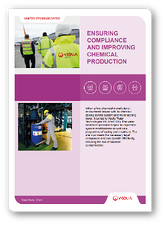The Importance of Water Cooling Systems
Extend the life and improve the efficiency of your water cooling system

We know how critical it is to keep cooling tower systems running efficiently and reliably in every industry, cooling does however incur high operational costs. Scaling, corrosion, and microbiological growth constitute major issues that can reduce performance, cause system downtime and threaten the health and safety of operators because of Legionella.
Operators need to work with their water treatment professionals to balance cooling tower blowdown control with proper cooling tower chemical treatment and establish appropriate control parameters which optimise water usage and heat exchange efficiency in their cooling tower systems.
Once-through cooling allows water to be used once for cooling before it is discharged. Cooling towers allow the same water to be used repeatedly for cooling before it is discharged. What limits the number of times the same water can be used is the solubility of various dissolved ions in the water. When concentrated high enough, some dissolved ions will become insoluble and start forming scale in the system. Typically, calcium carbonate is the first species to cause scale.
For example, for a cooling tower system with a temperature change of 10 F and running at 3 cycles of concentration (cycles), 1KL of makeup water gets used an average of 145 times before it is discharged via blowdown. That is much more efficient than 1KL of water only used one time in once-through cooling. On a yearly average, approximately 75% of the cooling action in a cooling tower results from evaporation, while 25% is transferred to the air through sensible heat.
Learn how we helped this site remain compliant
Energy Efficiency
Inefficient heat transfer will translate to an increase in energy consumption, which contributes to a larger carbon footprint. Overall, this causes both an impact on the environment as well as increasing site utility OPEX.
We deliver programs that improve the cleanliness of heat transfer surfaces, reducing energy waste. Using expert tools to measure the performance of the heat exchanger and demonstrate trending on operating efficiency against the original design. As a result, our programs deliver:
- Reduced costs
- Improved carbon footprint
- Commitment to sustainability goals
Water Optimisation
With a greater concern on regional water scarcity and an increase in the cost of potable water, water optimisation within cooling systems should be an important consideration for any water treatment control scheme.
We will look holistically at your water treatment challenges and design a program aligned with the outcomes of a detailed survey addressing the mechanical, operational and chemical considerations of your cooling water system. As a result, our programs deliver:
- Reduced water costs
- Improved water footprint
- Commitment to sustainability goals
Asset Protection
Poor water treatment control strategies can lead to corrosion occurring within the metallurgy of the system.
The loss of metal from corrosion can lead to plant and equipment failure as well as downstream consequences of heavy metals with discharge water.
Our aim is to protect your assets by thinking holistically of the cooling systems water treatment needs, employing corrosion inhibitors specific to your requirements.
- Reduced operational downtime
- Improved compliance
- Reduced heavy metal in discharge water



